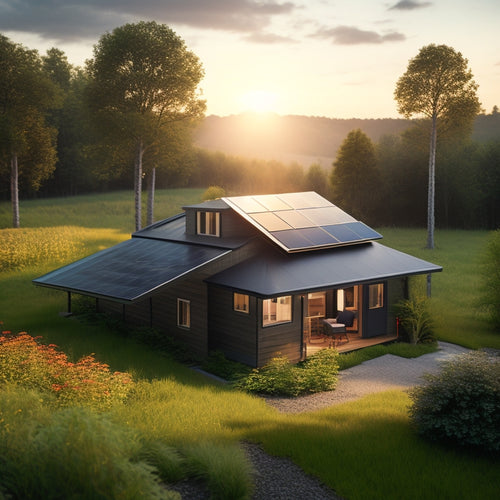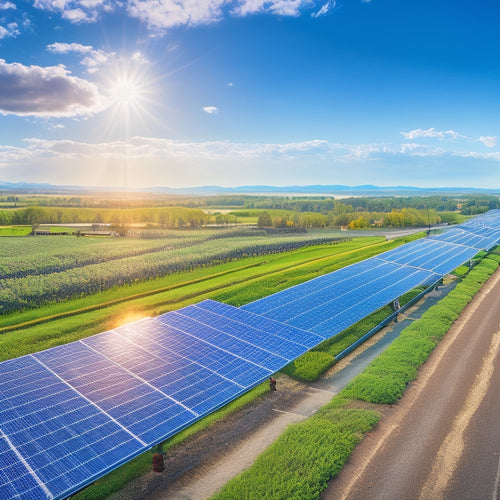
Monocrystalline Solar Panels Vs Thin-Film Solar Panels
Share
When you're choosing between monocrystalline and thin-film solar panels, consider efficiency, space requirements, and durability. Monocrystalline panels have a higher energy conversion rate (15-22%) and require less space, making them perfect for tight areas. They also last longer, often exceeding 25 years, while thin-film panels typically last 10-20 years. Maintenance is minimal for monocrystalline panels, enhancing their appeal despite higher upfront costs. Although thin-film options may seem cheaper initially, they often require more units for equivalent output, potentially increasing your long-term expenses. For a deeper analysis on which option suits you best, keep exploring the details.
At a Glance
- Monocrystalline panels offer higher efficiency (15-22%) compared to thin-film panels (10-12%), leading to greater energy production and savings.
- Monocrystalline panels require less installation space, making them ideal for compact areas, while thin-film panels need larger installations.
- Monocrystalline panels have a longer lifespan (over 25 years) compared to thin-film panels (10-20 years), making them a better long-term investment.
- Monocrystalline panels are more durable and resistant to extreme weather, while thin-film panels may struggle in harsh conditions.
- Although monocrystalline panels have higher upfront costs, their long-term efficiency and lower maintenance often justify the investment.
Efficiency in Limited Space
When you're working with limited space for solar installation, maximizing space utilization becomes essential.
Monocrystalline panels typically offer higher power output compared to thin-film options, making them more suitable for compact areas.
Additionally, high-efficiency solar panels convert more sunlight into usable power, further enhancing energy production in smaller footprints.
Understanding the differences in efficiency can help you make an informed decision for your specific needs.
Space Utilization Efficiency
In limited space scenarios, maximizing energy output is essential, and this is where the differences between monocrystalline and thin-film solar panels become apparent.
Monocrystalline panels typically offer higher efficiency rates, meaning they convert more sunlight into electricity in a smaller area. This makes them ideal for rooftops or compact installations where every square foot counts. Their sleek design optimization allows for greater energy yield without requiring extensive space.
On the other hand, thin-film panels, while often more flexible and lightweight, generally have lower efficiency. This can necessitate more extensive installation techniques to achieve the same energy output as monocrystalline panels, potentially leading to larger installations that may not fit in constrained environments.
When you're considering how best to employ limited space, think about your energy needs and the available area. If your priority is to maximize output in a small footprint, monocrystalline panels are likely the better choice.
However, if you have a bit more room and value flexibility, thin-film panels might still be worth considering. Ultimately, the right option depends on balancing efficiency with the specific limitations of your installation site.
Power Output Comparison
Comparing the power output of monocrystalline and thin-film solar panels reveals significant differences in efficiency, especially in limited space scenarios. Monocrystalline panels, known for their high efficiency, typically deliver around 15-22% energy conversion rates. This makes them ideal for installations where every square foot counts.
On the other hand, thin-film panels usually range from 10-12% efficiency, requiring more area to generate equivalent power.
When conducting a cost analysis, consider not just installation factors but also long-term savings. Monocrystalline systems often have higher upfront costs but can yield better performance metrics over time due to their efficiency.
Maintenance requirements are generally lower for monocrystalline panels, which can enhance their appeal.
Advancements in technology are pushing both types toward better performance and energy storage capabilities. Market trends indicate a growing preference for monocrystalline due to aesthetic preferences and system integration ease.
However, thin-film panels may offer flexibility for unique applications. Ultimately, choosing between them depends on your specific needs, available space, and desired freedom in energy management.
Evaluating these factors will guide you to the best decision for your solar energy goals.
Higher Energy Output per Panel
When comparing the energy output of monocrystalline and thin-film solar panels, efficiency ratings play a vital role.
You'll find that monocrystalline panels generally offer higher efficiency, allowing for greater energy production in limited space.
This higher efficiency often translates to long-term savings on energy bills and maximizes energy generation potential.
Understanding these differences helps you assess which option best meets your energy needs and spatial constraints.
Efficiency Ratings Comparison
While both monocrystalline and thin-film solar panels serve the same purpose of converting sunlight into electricity, their efficiency ratings reveal significant differences in energy output per panel. Monocrystalline panels typically boast efficiency ratings between 15% to 22%, allowing them to generate more electricity from the same amount of sunlight compared to thin-film options, which generally range from 10% to 13%.
This difference impacts your overall energy yield, especially if you're working with limited roof space.
When considering a cost comparison, higher efficiency in monocrystalline panels can translate into fewer panels required to meet your energy needs, potentially lowering the overall installation complexity.
Moreover, while thin-film panels might offer a lower initial investment, their efficiency can lead to higher long-term costs as you may need more units to achieve the same output.
Ultimately, if energy output per panel is your priority, monocrystalline options are usually more effective. However, your specific situation might influence which panel type suits your needs best, balancing factors like installation complexity and budget constraints.
Space Requirements Analysis
The efficiency ratings of monocrystalline and thin-film solar panels directly impact the space requirements for installation. Monocrystalline panels, known for their higher energy output per panel, require less installation space compared to their thin-film counterparts. This efficiency allows you to maximize energy production even with limited roof orientation or available land.
When considering panel aesthetics, monocrystalline panels often present a sleek look that can enhance your property's value. However, you'll need to account for zoning regulations that might dictate how many panels you can install based on your land use.
Accessibility considerations are vital, especially for maintenance space. Monocrystalline panels, being more efficient, may require less frequent maintenance, thereby reducing the need for extensive access routes.
If you're planning for future expansion, the compact nature of monocrystalline panels means you can easily add capacity without overwhelming your installation area. In contrast, thin-film panels, while easier to install in certain settings, often necessitate more space due to their lower efficiency, which may limit your options for future upgrades.
Ultimately, understanding these space requirements helps you make an informed decision for your solar energy needs.
Panel Durability and Lifespan
When evaluating solar panels, you'll want to contemplate their lifespan and environmental resistance.
Monocrystalline panels typically offer a longer lifespan, often exceeding 25 years, while thin-film panels tend to have a shorter operational period.
Additionally, advancements in solar power efficiency have made monocrystalline panels even more appealing for long-term investments.
Understanding these differences can greatly impact your long-term investment and energy efficiency.
Lifespan Comparison
Understanding the lifespan of solar panels is vital for making an informed investment. When you're considering monocrystalline versus thin-film solar panels, it's important to recognize that monocrystalline panels typically boast a lifespan of 25 years or more.
Their higher efficiency and durability often justify the initial installation costs, as they require less space and yield more energy over time.
On the other hand, thin-film solar panels generally have a shorter lifespan, averaging around 10 to 20 years. While they can be less expensive upfront and have lower installation costs, their shorter lifespan may lead to higher long-term expenses due to the need for replacement.
Maintenance requirements also differ between the two types. Monocrystalline panels usually demand minimal maintenance, primarily cleaning to guarantee peak performance.
In contrast, thin-film panels might require more frequent checks and maintenance, as their performance can degrade faster.
Environmental Resistance
Over time, environmental factors greatly impact the durability and lifespan of solar panels. When you weigh your options between monocrystalline and thin-film solar panels, understanding their environmental resistance is essential. Both types exhibit varying levels of temperature tolerance, moisture resistance, UV stability, weather durability, and corrosion resistance.
Here's a quick comparison:
| Feature | Monocrystalline | Thin-Film |
|---|---|---|
| Temperature Tolerance | High | Moderate |
| Moisture Resistance | Excellent | Good |
| UV Stability | Outstanding | Moderate |
Monocrystalline panels generally have better environmental resistance, making them ideal for extreme weather conditions. They can withstand high temperatures and exhibit superior UV stability, ensuring long-term performance. Conversely, thin-film panels, while lightweight and flexible, often show less weather durability and temperature tolerance, which may affect their lifespan in harsh climates.
Both panel types have an environmental impact; however, choosing the right one for your needs can optimize energy production while minimizing degradation. Your choice will influence not only your energy efficiency but also how well your panels withstand the elements over time.
Assessing Your Energy Goals
When evaluating your energy goals, consider how energy efficiency aligns with your consumption needs.
Home energy storage systems can also play an essential role in maximizing energy efficiency and energy independence while helping you manage your usage effectively.
You'll also need to assess your available space and installation requirements, as these factors greatly influence your choice between monocrystalline and thin-film solar panels.
Understanding these elements helps guarantee you make a well-informed decision that meets both your energy demands and physical constraints.
Energy Efficiency Considerations
Evaluating your energy goals is vital when choosing between monocrystalline and thin-film solar panels. Start by considering the energy efficiency of each option. Monocrystalline panels typically offer higher efficiency rates, often exceeding 20%, making them ideal for those with limited roof space. If maximizing energy output is your primary goal, these panels would serve you well.
On the other hand, thin-film solar panels have lower efficiency, generally around 10-12%. However, they perform better in low-light conditions and high temperatures, which might align with your specific energy needs depending on your location.
Cost considerations also play an important role. Monocrystalline panels usually come with a higher upfront cost, but their long-term energy production can offset this initial investment. Thin-film panels are less expensive initially, but you might need more units to meet your energy requirements, which could increase long-term costs.
Lastly, maintenance requirements differ. Monocrystalline panels tend to have a longer lifespan with fewer maintenance needs compared to thin-film options.
As you assess your energy goals, weigh these factors carefully to make an informed decision that aligns with your aspirations for energy independence.
Space and Installation Needs
Choosing the right solar panel system involves careful consideration of your available space and installation needs.
Monocrystalline panels, known for their high efficiency, require less space due to their higher output. This makes them ideal for homeowners with limited roof area. However, their installation can present challenges, particularly regarding weight and structural support. You'll need to evaluate whether your roof can handle their installation without reinforcement.
On the other hand, thin-film solar panels are lighter and more flexible, making them suitable for various surfaces, including unconventional roofs. This flexibility can aid in space optimization, allowing you to employ areas that monocrystalline panels mightn't effectively cover.
However, keep in mind that thin-film panels generally require more space to produce the same amount of energy as their monocrystalline counterparts, which could lead to installation challenges if space is limited.
Ultimately, evaluating your energy goals and understanding your property's constraints will guide you to the best choice.
Higher Performance in Low Light
When considering solar panel options, it's essential to analyze how each type performs in low light conditions.
Monocrystalline panels generally excel in efficiency, even when shaded, making them a reliable choice for areas with variable sunlight.
In contrast, thin-film panels may struggle, which could impact your overall energy production during overcast days or in shaded environments.
Efficiency in Shade Conditions
Many homeowners wonder how solar panels perform under less-than-ideal lighting conditions, particularly in shaded areas. When it comes to efficiency in shade conditions, monocrystalline solar panels generally exhibit superior shade tolerance compared to thin-film alternatives. This is largely due to their higher efficiency ratings and the way they're constructed.
Monocrystalline panels consist of tightly packed silicon cells, which allow for better energy production even when light levels drop. In shaded conditions, you might notice significant performance variability between the two types of panels. Monocrystalline panels can still generate power when partially shaded, minimizing the impact on your overall energy production.
In contrast, thin-film panels can struggle in these situations, as their lower efficiency means that even a small amount of shade can lead to a more considerable drop in output. If you're considering solar panels for a property with potential shading issues, opting for monocrystalline panels could provide greater reliability and performance.
This choice allows you to maximize your energy independence, ensuring that you utilize as much sunlight as possible, even when conditions aren't ideal. Ultimately, understanding how each type performs in shade can enhance your decision-making process.
Frequently Asked Questions
What Are the Installation Costs for Monocrystalline Vs Thin-Film Panels?
When considering installation costs, you'll need to evaluate various installation factors, including labor and materials. A thorough cost comparison between different panel types can help you make an informed decision that suits your energy needs.
How Do Weather Conditions Affect Each Panel Type's Performance?
Weather conditions greatly influence solar panel performance. Extreme temperatures can reduce efficiency, while high humidity affects energy output. You'll need to take into account these factors when evaluating how well your chosen panels will perform in varying climates.
What Is the Recycling Process for Solar Panels?
When you think about solar panel recycling, consider end of life management. You'll find precious materials like silicon and metals recovered, ensuring a sustainable cycle that minimizes waste and maximizes resource efficiency for future energy solutions.
Are There Any Incentives for Choosing One Panel Type Over the Other?
Yes, you'll find various government subsidies and financial incentives available for solar panel installation. These can greatly reduce your upfront costs, making it easier for you to choose the most suitable option for your energy needs.
How Do Maintenance Requirements Differ Between Monocrystalline and Thin-Film Panels?
Imagine sunlight dancing on your panels. With monocrystalline, you'll find fewer cleaning techniques needed due to dirt resistance. Thin-film might require more upkeep, but both boast impressive lifespans, ensuring long-term energy freedom for you.
Explore More
In choosing between monocrystalline and thin-film solar panels, it's crucial to align your decision with your specific energy needs and space constraints. Monocrystalline panels typically offer higher efficiency and durability, while thin-film panels excel in versatility and performance in low light. So, which type best suits your unique situation? By carefully evaluating these factors, you can make an informed choice that maximizes your energy output and investment over time, ensuring you utilize the sun's power effectively.
Related Posts
-

Smart Home Thermostats to Revolutionize Your Space
Smart home thermostats revolutionize your space by providing precise temperature control and optimizing energy saving...
-

Diy Off Grid Solar
By embracing DIY off-grid solar, you can break free from grid dependence, slashing your energy bills by up to 90% and...
-

Applications of Photovoltaic Systems
Photovoltaic systems are versatile, converting sunlight into electricity for various applications. You can use them i...


